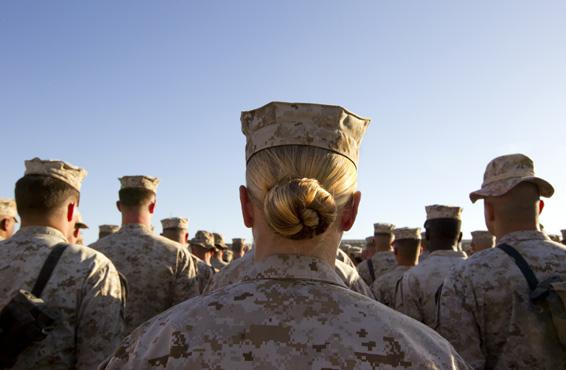Ten years ago, as I prepared to take part in the invasion of Iraq, I never thought women would be allowed to serve in combat jobs in the U.S. military, at least not in my lifetime. To be honest, I wasn’t even sure it was a good idea.
Some of my male comrades in the 101st Airborne Division (Air Assault) had even clearer thoughts on the question. They told me, sometimes to my face, that I didn’t belong in the military at all, much less in a combat zone. Women serving in the infantry was simply anathema to them.
Then we crossed the berm into Iraq and drove into Baghdad. Suddenly, my skills as an Arabic linguist were more important than my gender: On combat foot patrols with infantry troops, my ability to help successfully accomplish the mission was the only thing that mattered. During major combat operations, the fact that I was a woman was only meaningful if my presence made it easier for the guys to interact with local women. Some Iraqi women were prevented by custom or religion from talking to men; others were simply terrified of huge soldiers strapped in military gear suddenly appearing at their door. The presence of another woman sometimes calmed them and give them the comfort level to tell us about threats in their neighborhood.
After I returned home, I started to question my earlier doubts. In time, I became convinced that although the older generation of military leaders may not have been prepared to see women attain full equality in uniform, the troops I served alongside would be ready once they moved into leadership positions. They would have seen women medics, helicopter pilots, and food specialists serve in combat. Women like Monica Lin Brown, an Army medic who was awarded the Silver Star for her combat valor in Afghanistan; Tammy Duckworth, a helicopter pilot who lost both her legs due to injuries sustained in combat in Iraq; and Shoshana Johnson, a food service specialist who became the first African American female POW when her unit was ambushed in Iraq.
The men and women I served with saw that Americans did not rise up in protest when more than 150 female U.S. servicemembers gave their lives in Iraq and Afghanistan. Rather, the public accepted that women who chose to volunteer for military service did so knowing the risks, and grieved for them just as they did for the men who made the ultimate sacrifice.
Those who served in Iraq and Afghanistan came to understand that in complex counterinsurgency operations, especially in Muslim nations, the presence of women troops is a vital way to interact with the civilian population—so important, in fact, that military leaders have long been skirting the old regulations by placing women in combat units.
Today, when Secretary of Defense Leon Panetta announces the repeal of the combat ban on women soldiers, the policy will finally catch up to the reality that many of us who have served in Iraq and Afghanistan already know. It will be now be up to the services to demonstrate that women should be banned from specific jobs, rather than there being a blanket ban on women in all ground combat roles and smaller units whose primary mission is direct ground combat. It is a tremendous step forward. The fact that the final push has come from within the military speaks volumes for how vital women have become to operational success.
Much work remains to be done to implement this landmark reform. It is likely that the military will follow a multiyear process for phasing in changes, similar to that planned by the Australian military. Australia began allowing women to transfer between services into combat roles this month and will allow female recruits to enter those jobs directly in January 2016. The Aussies believe these changes will be fully implemented later that same year.
The U.S. military services (particularly the Army and Marines) may argue that some jobs, particularly in the Special Forces, should remain closed to women. But as women continue to prove their abilities in a growing number of positions, those exclusions will become harder to justify.
It is true that not all women can handle the physical demands of military service. However, neither can all men. In fact, only 25 percent of today’s young people qualify for military service at all—the rest are too obese, too poorly educated, or have criminal backgrounds that bar them. Today Panetta is acknowledging that to maintain the high standards of the military, assignments should be based on ability, not gender.
There will be challenges, just as there are with any policy change across the military. However, the dire predictions of catastrophe in the wake of the repeal of “don’t ask, don’t tell” were gratifyingly overwrought. The pundits who claimed the military would not be able to handle gays serving openly are typically the same ones who argue against women serving equally; I am convinced they will be just as wrong this time as they were then. Today women in the military will revel at the news. Tomorrow they will go back to work.
